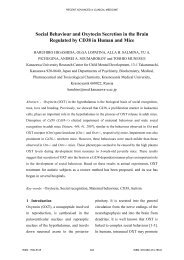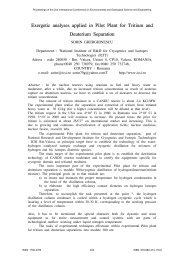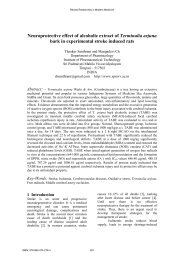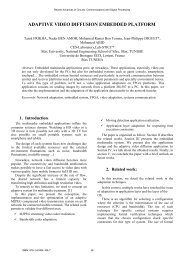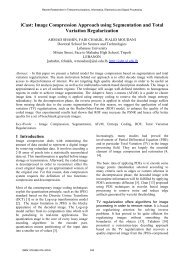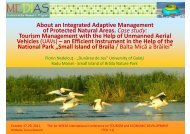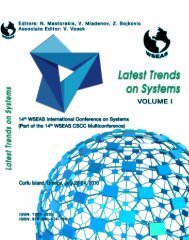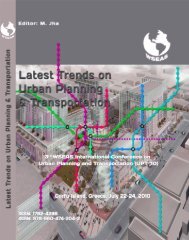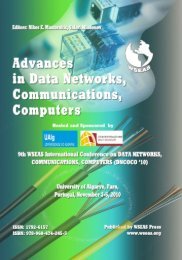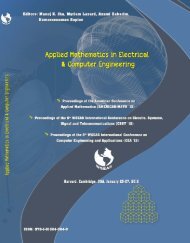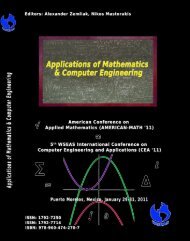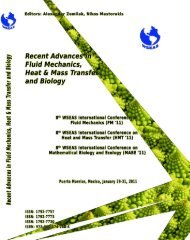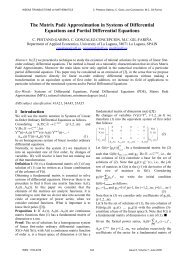Continuum mechanics - WSEAS
Continuum mechanics - WSEAS
Continuum mechanics - WSEAS
Create successful ePaper yourself
Turn your PDF publications into a flip-book with our unique Google optimized e-Paper software.
CONTINUUM MECHANICS,FLUIDS, HEATProceedings of the 5th IASME / <strong>WSEAS</strong> International Conference onCONTINUUM MECHANICS (CM '10)Proceedings of the 7th <strong>WSEAS</strong> International Conference on FLUIDMECHANICS (FLUIDS '10)Proceedings of the 7th <strong>WSEAS</strong> International Conference on HEATand MASS TRANSFER (HMT '10)University of Cambridge, UKFebruary 23-25, 2010<strong>WSEAS</strong> Mechanical Engineering SeriesA Series of Reference Books and TextbooksPublished by <strong>WSEAS</strong> Presswww.wseas.orgISSN: 1790-5095ISBN: 978-960-474-158-8
CONTINUUM MECHANICS,FLUIDS, HEATProceedings of the 5th IASME / <strong>WSEAS</strong> International Conference onCONTINUUM MECHANICS (CM '10)Proceedings of the 7th <strong>WSEAS</strong> International Conference on FLUIDMECHANICS (FLUIDS '10)Proceedings of the 7th <strong>WSEAS</strong> International Conference on HEATand MASS TRANSFER (HMT '10)University of Cambridge, UKFebruary 23-25, 2010<strong>WSEAS</strong> Mechanical Engineering SeriesA Series of Reference Books and TextbooksPublished by <strong>WSEAS</strong> Presswww.wseas.orgCopyright © 2010, by <strong>WSEAS</strong> PressAll the copyright of the present book belongs to the World Scientific and Engineering Academy andSociety Press. All rights reserved. No part of this publication may be reproduced, stored in a retrievalsystem, or transmitted in any form or by any means, electronic, mechanical, photocopying, recording, orotherwise, without the prior written permission of the Editor of World Scientific and Engineering Academyand Society Press.All papers of the present volume were peer reviewed by two independent reviewers. Acceptance wasgranted when both reviewers' recommendations were positive.See also: http://www.worldses.org/review/index.htmlISSN: 1790-5095ISBN: 978-960-474-158-8World Scientific and Engineering Academy and Society
CONTINUUM MECHANICS,FLUIDS, HEATProceedings of the 5th IASME / <strong>WSEAS</strong> International Conference onCONTINUUM MECHANICS (CM '10)Proceedings of the 7th <strong>WSEAS</strong> International Conference on FLUIDMECHANICS (FLUIDS '10)Proceedings of the 7th <strong>WSEAS</strong> International Conference on HEATand MASS TRANSFER (HMT '10)University of Cambridge, UKFebruary 23-25, 2010
Michael Aronov, UNITED STATESMohammadmasoud Azhdari moghaddam, IRANRegita Bendikiene, LITHUANIAHelmut Benigni, AUSTRIAA. C. Benim, GERMANYFriedrich-Karl Benra, GERMANYStasys Bockus, LITHUANIAHermenegildo Borges de Oliveira, PORTUGALMircea Boscoianu, ROMANIAMalek Bouhadef, ALGERIAAndris Buikis, LATVIAAdriana Catanase, ROMANIACostin Cepisca, ROMANIAClaudia Cherubini, ITALYAshfaque Ahmed Chowdhury, AUSTRALIAJ. P. Curtis, UKFarhang Daneshmand, IRANGeorge Darie, ROMANIAKonrad Domke POLANDMichel El Hayek, LEBANONTayfour Elbashir, OMANArpad Fay, HUNGARYPetr Filip, CZECH REPUBLICNicolas Galanis, CANADASergey Gaponov, RUSSIAAitor J. Garrido, SPAINmajid Ghassemi, IRANYury Gogotsi, UNITED STATESJonas Gyly,USAVasileios Hamosfakidis, UNITED STATESAssia Helali, FRANCEJun Huang, FINLANDDagmar Janacova, CZECH REPUBLICMak Kai Long, HONG KONG S. A. R.X.Kakatsios, GREECEBouhadef Khedidja, ALGERIAJaewon Kim, KOREAKarel Kolomaznik, CZECH REPUBLICPavel Kuibin, RUSSIAAlbert Kurbatskiy, RUSSIAT.-W. Lee, UNITED STATESV. C. Loukopoulos, GREECEFathi Mahfouz, EGYPTD. S. Mathioulakis, GREECEMohamed Maidi, UNITED KINGDOMElena Martin, SPAINSushanta K Mitra, INDIADawid Myszka, POLANDSantirat Nansaarng, THAILANDJiri Neustupa, CZECH REPUBLICCong Tam Nguyen, CANADAGuillermo Paniagua, BELGIUMThales Papazoglou, GREECESophia Psychoudaki, GREECEYulia Peet, FRANCEGuillaume Polidori, FRANCEJiri Pospisil, CZECH REPUBLICThomas Prevenslik, GERMANYRobert Pucher, AUSTRIAMohammad Rasul, AUSTRALIAMourad Rebay, FRANCEConstantin Rotaru, ROMANIAGilles Roy, CANADASaeed-Reza Sabbagh-Yazdi, IRANM. Sakellariou-Makrantonaki, GREECELamberto Tronchin, ITALYMartin van den Toorn, THE NETHERLANDSHeimo Walter, AUSTRIAYing Wang, CHINADirk Weltersbach, GERMANYHenning Zindler, GERMANY
PrefaceThis year the 5th IASME / <strong>WSEAS</strong> International Conference on CONTINUUM MECHANICS(CM '10), the 7th <strong>WSEAS</strong> International Conference on FLUID MECHANICS (FLUIDS '10) andthe 7th <strong>WSEAS</strong> International Conference on HEAT and MASS TRANSFER (HMT '10) wereheld at the University of Cambridge, UK, February 23-25, 2010. The conferences remain faithfulto their original idea of providing a platform to discuss solid <strong>mechanics</strong>, fluid <strong>mechanics</strong>, gas<strong>mechanics</strong>, hydraulics, heat and mass transfer, air pollution problems, mathematical models incontinuum <strong>mechanics</strong>, experimental techniques in continuum <strong>mechanics</strong>, hydrotechnology,turbomachinery, propulsion systems, meteorology, water resources management, thermalengineering, turbomachinery, geoscience, solar energy, clean technologies, applications ofthermal science in astronomy and space science, urban areas and heat pollution etc. withparticipants from all over the world, both from academia and from industry.Their success is reflected in the papers received, with participants coming from several countries,allowing a real multinational multicultural exchange of experiences and ideas.The accepted papers of these conferences are published in this Book that will be indexed by ISI.Please, check it: www.worldses.org/indexes as well as in the CD-ROM Proceedings. They willbe also available in the E-Library of the <strong>WSEAS</strong>. The best papers will be also promoted in manyJournals for further evaluation.Conferences such as these can only succeed as a team effort, so the Editors want to thank theInternational Scientific Committee and the Reviewers for their excellent work in reviewing thepapers as well as their invaluable input and advice.The Editors
CONTINUUM MECHANICS, FLUIDS, HEATTable of ContentsPlenary Lecture 1: Hamiltonian Formalisms Applied to <strong>Continuum</strong> Mechanics Potential Usefor Fracture MechanicsNaman Recho13Plenary Lecture 2: Unsteady Flow Simulation In Turbomachinery - A Numerical Challenge 14Francesco MartelliPlenary Lecture 3: Adequate Modeling of Fluid Flows 16Yuli D. ChashechkinPlenary Lecture 4: <strong>Continuum</strong> Versus Quantum Fields Viewed Through a Scale InvariantModel of Statistical MechanicsSiavash H. SohrabPlenary Lecture 5: Advances on Characteristics Changing and Working State Degrading ofPassive Vibroisolation ElementsSilviu NastacPlenary Lecture 6: Special and Unusual Aspects Regarding Real Scale Impact Testing Methodsfor Large BeamsCarmen DebeleacHyperbolic Heat Equation as Mathematical Model for Steel Quenching of L-Shape Samples,Part 2 (Inverse Problem)Tabita Bobinska, Margarita Buike, Andris Buikis17181921Fox H-Function as Solution for a Rotating Flow of Non-Newtonian Fluids 27Stelian TurbatuElastic-Plastic Deformation of a Thin Rotating Disk of Exponentially Varying Thickness andInclusionSanjeev Sharama, Manoj Sahni, Ravindra Kumar33Using Morlet Wavelet Coefficients to Cluster Variable Amplitude Fatigue Features 42S. Abdullah, T. E. Putra, M. Z. Nuawi, Z. M. Nopiah, A. Arifin, A. LennieAcceleration and Retardation of Cracks in Heterogeneous Materials (Hamiltonian Approach) 49N. I. Chekunaev, A. M. KaplanComment on Specific Features of Optomechanical Fits 54Corina Gruescu, Ioan Nicoara, Gilbert-Rainer Gillich, Ionica CarabasFailure Analysis of a Kaplan Turbine Runner Blade by Metallographic and NumericalMethodsDoina Frunzaverde, Viorel Campian, Dorian Nedelcu, Gilbert-Rainer Gillich, Gabriela Marginean60On the Propagation of Finite-Amplitude Acoustic Waves in Mono-Relaxing Media 67P. M. Jordan, G. V. Norton, S. A. Chin-Bing, A. Warn-VarnasNatural Convection Heat Transfer Below a Heated Downward-Facing Disk in Air 73H. Chehouani, A. ElmotassadeqISSN: 1790-5095 9 ISBN: 978-960-474-158-8
CONTINUUM MECHANICS, FLUIDS, HEATSimulation of Velocities and Pressures Distribution on Blade of Pump-Turbine Runner 190Anton Iosif, Ioan SarbuExperimental Investigation of the Near Wake of a Trailer 196V. Barzanooni, A. KhoshnevisA New Analytical Solution for Deformation and Stresses in Functionally Graded Rotatingcylinder Subjected to Thermal and Mechanical LoadsA. R. Khorshidvand, S. M. R. KhaliliExperimental Study of Fuel Lean Reburning for NOx Reduction in Oxygen EnhancedCombustionChang Hwan Hwang, Seung Wook Baek, Hak Young Kim201205Pool Boiling Heat Transfer to Pure Liquids 211S. A. Alavi Fazel, S. RoumanaOptimization of a Natural Gas Distribution Pipeline Network in a Village of Kurdistan, Iran 217Masood EbrahimiEnergy Loss of Compressed Air Systems in 12 Companies 221Masood EbrahimiExtracting Surface Temperatures from Depth Average Numerical Solution Near ThermalWater Discharge from Bottom DiffusersSafora Seddigh-Marvasti, Saeed-Reza Sabbagh-Yazdi, Nikos E. MastorakisExperiments and Two Different Turbulence Models Comparisons on Thermal MixingPhenomenon in a Tee PipingChao-Jen Li, Yao-Long Tsai, Tai-Ping Tsai, Li-Hua WangSolitary Wave Solutions of a Fifth Order Model Equation for Steady Capillary-Gravity Wavesover a Bump with the Bond Number Near 1/3Chung-Hsien Tsai, Shy-Jen Guo225231236Modeling Air Flow over Structured Surfaces 241D. N. RiahiNumerical Study on the Flow Characteristics of a Solenoid Valve for Industrial Applications 246Taewoo Kim, Ranjith Maniyeri, Park Soochul, Sangmo KangPrediction of Transient Deflector Plate Temperature During Rocket Plume Impingment andits Validation through ExperimentsPriya Kamesh Kamatchi, Vishnu Pooviah, J. C. Pisharady252Numerical Analysis of a Turbocompounded Diesel – Brayton Combined Cycle 258S. Shreyas Krishna, C. J. Thomas RenaldNumerical Investigation of Swirl's Effects in the Outer Annulus of a Reverse-flow Gas TurbineCombustorMostafa Ghanei Tayeblou, Kavous AriafarThermal Analysis of Freezing Front Propagation in a Liquid, Homogeneous and IsotropicMediumDiana Enescu, Otilia Nedelcu, Elena Otilia Virjoghe, Cornel Salisteanu262267ISSN: 1790-5095 11 ISBN: 978-960-474-158-8
CONTINUUM MECHANICS, FLUIDS, HEATInvestigation of Flow Pattern and Pressure Loss of a V94.2.5 Gas Turbine Air Intake SystemUsing 3D Numerical ModelingKhashayar Khorsand, S. M. H. Karimian, M. Varmaziar, S. SarjamiIntegral Parabolic Spline with Jump for Discontinuous Mathematical Problems in LayeredMediaSolvita Kostjukova, Andris Buikis273279Research of an Auto Transportation Monitoring System using a Dimensions Basis Approach 283Stela Dinescu, Anamaria GiurgiulescuA Numerical Solution for the Effect of Radiation on Micropolar Flow and Heat Transfer Past aHorizontal Stretching Sheet through Porous MediumR. Bhargava, Rajesh Sharma, O. Anwar Beg288An Approximate Dynamic Analysis of Multistory Structures 297Semih Kucukarslan, Yalcin KumbasarThermal Instability of a Rotating Viscoelastic Fluid Permeated with Suspended Particles inHydromagneticsA. K. Aggarwal, Anushri Verma302Authors Index 307ISSN: 1790-5095 12 ISBN: 978-960-474-158-8
CONTINUUM MECHANICS, FLUIDS, HEATPlenary Lecture 1Hamiltonian Formalisms Applied to <strong>Continuum</strong> Mechanics Potential Use for FractureMechanicsProfessor Naman RechoERMESS/ EPF-Ecoles d'Ingenieurs, Sceaux andLaMI, University Blaise Pascal, Clermont IIFranceE-mail: naman.recho@epf.frAbstract: The first part of this paper deals with several Hamiltonian formalisms in elasticity. We first present brieflythe formalisms of Zhong and Bui, (Bui, [1]; Zhong, [2]), which resolve respectively the two-end problem and theCauchy problem in elasticity. Then we propose a new Hamiltonian formalism, which resolves simultaneously the twoproblems mentioned above and it shows the link between the two formalisms. The potential use for fracture<strong>mechanics</strong> purposes is then mentioned. In fact, when traditional theories in fracture <strong>mechanics</strong> are used, asymptoticanalyses are often carried out by using high-order differential equations governing the stress field near the crack tip.The solution of the high-order differential equations becomes difficult when one deals with anisotropic or multiplayermedia etc. The key of our idea is to introduce the Hamiltonian system, usually studied in rational <strong>mechanics</strong>, intocontinuum <strong>mechanics</strong> also, one can obtain a system of first-order differential equations, instead of the high-orderdifferential equation. This method is very efficient and quite simple to obtain solution of the governing equations ofthis class of problems. It allows dealing with large range of problems, which may be difficult to resolve by usingtraditional methods.By using this approach, we have resolved various problems. Some of them have been solved previously and somenot yet. We see that the present method is particularly efficient for resolving multi-material problems. So the multimaterialproblem can be resolved as a single material problem through the construction of a transfer matrix.We believe that a large domain can be found in applying this new approach into fracture <strong>mechanics</strong>.Brief Biography of the Speaker:Naman Recho is a Professor at the University Blaise Pascal in Clermont Ferrand, France, he is also head ofERMESS- Research laboratory (Equipe de Recherche en Mecanique et Securite des Structures) at EPF Engineeringschool in Sceaux, France.He has worked extensively with conceptual and applied aspects of fracture <strong>mechanics</strong>, with welded offshorestructures and reliability analysis of cracked structures. He also teaches at Centre des Hautes Etudes de laConstruction, Paris, and is guest Professor at Hefei University of Technology in China.Professor Naman Recho was educated at the French University of Pierre and Marie Curie in Paris. He graduated inthis university as Doctor Engineer in 1980 and "Docteur d'Etat Es-Sciences Physiques" in 1987. He is full Professorsince 1988. He is delegate (Delegation CNRS) at National Centre of Scientific Research in Paris 2005-2007 and haswritten three textbooks within Fracture Mechanics and Fatigue Analysis.In the recent 10 years, he directed more than 15 theses dealing with fracture <strong>mechanics</strong> and fatigue design of weldedjoints and participated into several research programs with industries.ISSN: 1790-5095 13 ISBN: 978-960-474-158-8
CONTINUUM MECHANICS, FLUIDS, HEATPlenary Lecture 2Unsteady Flow Simulation In TurbomachineryA Numerical ChallengeProfessor Francesco MartelliEnergetics Dept. "S. Stecco" - University of FlorenceFirenze - ItalyE-mail: francesco.martelli@unifi.itAbstract: The prediction of unsteady flow field in turbine blades as well as in the turbomachinery stages is now anaffordable item, and is required by the reduced margin for increasing efficiency, stability and life of propulsioncomponents. The numerical tools are now capable to run within reasonable time 3D unsteady calculation for fullstage, and the new techniques on the computation and parallel computer allow the improvements of results in termsof cost and accuracy. Despite this advantages many questions remain open and the physical modelling joint with thenumerical improvements is still a challenge if it has to produce usable results ,compared with the experiments. On theother side the huge amount of data extracted from experiments require care and skillness to become usefull tools fordesign. The two activity interact and support each other in the attempt to improve design quality.Aim of this paper is the report on some experience and the attempt to give some answer on that challenge,presenting results of an resent activity on modelling side compared with experiments as well.A full-3D unstructured solver based on an upwind TVD finite volume scheme is developed and applied to thesimulation of an unsteady turbine stage. Two different approaches are considered for the time accurate inviscidsimulation of the unsteady stator/rotor interaction. The first consists of a classical explicit time accurate multi-stepRunge-Kutta scheme. The second is based on a dual-time stepping strategy, which exploits the implicit timemarchingNewton-Krylov method. In this case the linear solver of the implicit scheme consists of a preconditionedGMRES and ILU(0) incomplete factorisation. Both the explicit and implicit approaches are designed to run on parallelcluster of workstations. The development of the numerical strategy is discussed with particular concern on thevalidation of the unsteady model through a comparison against experiments, NISRE approach and a 3D steady stagecomputation.The present work considers the application of the fully unstructured hybrid solver for internal viscous flows, as well.The multiblock version of the solver developed for turbine is considered, because of the highly improved performanceas compared to the single domain version of the code. Moreover, the high numerical costs involved in 3D unsteadycomputations required the development of a new parallel single program multiple-data version of the numericalsolver.The results compare favourably with a set of time averaged and unsteady experimental data available for the turbinestage under investigation, which is representative of a wide class of aero-engines. This improved version of HybFlowis applied to the simulation of the BRITE HP turbine stage experimentally tested in the compression tube facility CT3of the Von Karman Institute (Denos et al. 1999, 2000). Preliminary tests on viscous calculations show a goodcapability of the solver to manage complex flow conditions and geometry. Some example of calculation grids andresults are reported in following figures.ISSN: 1790-5095 14 ISBN: 978-960-474-158-8
CONTINUUM MECHANICS, FLUIDS, HEATIn the final version of the papers results and comparision on rotor stator interaction will be reported in more details,and comments and suggestion on the pen question will be discussed.ISSN: 1790-5095 15 ISBN: 978-960-474-158-8
CONTINUUM MECHANICS, FLUIDS, HEATPlenary Lecture 3Adequate Modeling of Fluid FlowsProfessor Yuli D. ChashechkinLaboratory of Fluid MechanicsInstitute for Problems in Mechanics of theRussian Academy of Science101/1 prospect Vernadskogo, Moscow, 119526 RUSSIAN FEDERATIONE-mail: chakin@ipmnet.ruAbstract: For definition of adequate analytical and laboratory modeling of fluid flows conditions the conventionalfundamental governing equations set is analyzed thoroughly. The basic equation in this approach is a state equationdefining a number of thermodynamic variables which are necessary to characterize properties of particular mediumand flow conditions. The total fundamental set of governing equations consisting of state, continuity and transport ofmomentum, temperature and constituent component equations is treated as singular disturbed system. Dissipativeproperties of the fluid are characterized by kinematic viscosity, temperature and diffusivity coefficients of constituent.General solutions of the linearized governing equations sets consist of regular and singular disturbed on dissipativefactors functions. All flow components are characterized by their scales. Regular disturbed solutions (redics) of theset describe waves and vortices. Rate of their dissipation is proportional to viscosity and other kinetic coefficients. Inlimiting case redics are matched continuously with solutions of appropriate Euler equations set. Rich family ofsingular disturbed functions (sidics) describes fine flow components. Sidics transverse length scales are defined bydissipative factors and intrinsic frequencies of the problem that are by frequency of buoyancy (or rotation) in stratified(or vortex) flows. Besides boundaries the fine flow components manifest themselves inside the fluids as interfaces.The sidics are responsible for energy dissipation, production and transport of vorticity and anisotropic transport ofcontaminants. In general non-linear description all flow components interact between themselves directly in spite ofthe scales differences. Illustrative experimental investigations of 2D and 3D periodic internal wave beams, lee wavesand wakes past uniformly moving obstacles in a continuously stratified fluid were performed in laboratory tanks usingmarkers, schlieren instruments and conductivity sensors. Restructuring of interfaces and their transformation intovortices and vortex systems were registered far from the solid boundaries directly inside the continuously stratifiedfluid. New structural elements that are "tubular structures" were visualized in the periodic internal wave beams.Extended singular components accumulate contaminants and provide their fast transport. Strong anisotropy of a dyetransport in a stationary compound vortex motion produced by uniformly rotating disc in cylindrical container wasobserved. Spiral arm was spinning from a dye drop put into center of surface trough produced by compound vortex.Set of all flow scales ratios form conditions of adequate laboratory modeling. Extrapolation of model data onenvironmental and technical conditions is discussed.Brief Biography of the Speaker:Yuli D. Chashechkin is head of the Laboratory of Fluid Mechanics of the A.Yu.Ishlinski Institute for Problems inMechanics of the Russian Academy of Sciences and professor of Physical Faculty of M.V.Lomonosov Moscow StateUniversity. His main research interests concern foundations of fluid <strong>mechanics</strong>, theory of stratified and rotating flows,optical visualization of fluid flows. In these fields, he authored or co-authored over 200 scientific papers published inreviewed journals or presented at international conferences. Well known his schlieren images of internal waves,convective flows, vortices and wakes. As invited research professor he visited and worked in a number of Westernand Eastern Universities including Arizona State University (USA), Ecole Normale Superior (Paris, France), TheTokyo University (Japan), University Toulon-Sud (France), University Polytechnic Catalonia (Barcelona, Spain) andothers. He took part in a number of national and international marine cruises for studying marine turbulence, finestructure and internal waves. He is European regional editor of Journal of Visualization, organizers of biannualconferences on Fluxes and Structures in Fluids and co-editor of their Selected Papers Volumes.ISSN: 1790-5095 16 ISBN: 978-960-474-158-8
CONTINUUM MECHANICS, FLUIDS, HEATPlenary Lecture 4<strong>Continuum</strong> Versus Quantum Fields Viewed Through a Scale Invariant Model of StatisticalMechanicsProfessor Siavash H. SohrabRobert McCormick School of Engineering and Applied ScienceDepartment of Mechanical EngineeringNorthwestern University, Evanston, Illinois 60208USAE-mail: s-sohrab@northwestern.eduAbstract: The scale invariant forms of the conservation equations will be applied to show that in the absence ofconvection the velocity field will be governed by non-homogenous diffusion equation similar to the density, thetemperature, the pressure, and the vorticity fields. The similarities and the underlying connections between physicalphenomena at various scales associated with geometric optics (Hamilton-Jacobi equation), electrodynamics(Schrodinger equation), statistical <strong>mechanics</strong> (Boltzmann equation), and hydrodynamics (Bernoulli equation) will beexplored. In particular, the physical basis of quantum <strong>mechanics</strong> and the associated double-slit and the EPRproblems will be addressed on the basis of a scale invariant description of Heisenberg matrix <strong>mechanics</strong> andSchrodinger equation. Furthermore, the nature of the connections between quantum versus continuum fields will beexplored and its impact on the success of Fourier representation of generalized functions will be discussed. Finally,some of the implications of a scale-invariant model of statistical <strong>mechanics</strong> to the physical foundation of analysis,non-Euclidean geometry, and prime number theory will be addressed.Brief Biography of the Speaker:Siavash H. Sohrab received his PhD in Engineering Physics in 1981 from University of California, San Diego, his MSdegree in Mechanical Engineering from San Jose State University in 1975, and his BS degree in MechanicalEngineering from the University of California, Davis in 1973. He then joined Northwestern University in 1982 aspostdoctoral research assistant and became Visiting Assistant Professor in 1983, Assistant Professor of MechanicalEngineering in 1984, and since 1990 he is Associate Professor of Mechanical Engineering at the NorthwesternUniversity. From 1975-1978 he worked as a scientist doing research on fire protection and turbulent combustion atNASA Ames research center in California. His research interests have been on combustion, fluid dynamics,thermodynamics, and statistical and quantum <strong>mechanics</strong>.ISSN: 1790-5095 17 ISBN: 978-960-474-158-8
CONTINUUM MECHANICS, FLUIDS, HEATPlenary Lecture 5Advances on Characteristics Changing and Working State Degrading of PassiveVibroisolation ElementsDr. Silviu NastacResearch Center for Mechanics of Machines and Technological EquipmentsUniversity "Dunarea de Jos" of GalatiCalea Calarasilor 29, 810017, BrailaRomaniaE-mail: snastac@ugal.roAbstract: This paper presents some special aspects regarding changing and degrading phenomenon of theoreticalcharacteristics for vibroisolation elements during the exploitation. The approaches are based on the internalthermodynamic phenomenon developed into the rubber elements subjected with the various and intensive dynamiccharges. The influences are involved about both the static and dynamic characteristics, and consist of rigidity anddamping parameters variation.The main area of this study is framed by the passive isolation against shocks and vibration, due to the differenttechnological equipments, of the sensitive embedded systems. Most of these isolation devices and systems arebased on rubber elements and in some exploitation cases it was remarked an unusual behavior or an untimelyevolution to a final damaged state.The analysis is based on the large sets of virtual and instrumental tests, performed for different types of vibroisolationelements, with various structural and functional configurations. All of these was developed supposing the basiccompressing and torsion rubber elastic elements, their working principle, and their functional restraints.Through the comparative analysis of the acquired results, with the computational dynamics simulation, it wasdeveloped a few theoretical and operational models. Besides of the thermodynamics phenomenon, that are happeninto the isolator, it was supposed the non-linear effects of damping and of rigidity that are usual characteristics of areal elements behavior. The reduction of transient states and decreasing the magnitude of permanent oscillations forspecific parameters (like rigidity, damping, natural frequency, etc) around their reference value was the major andpermanent purposes of this study.The main concluding remark denotes the differences between simple theoretical models results and the realelements evolution under the charges. Because of the shifting and modification of the static and dynamiccharacteristics, the final evolution of the isolator may acquire unbalanced values for specific parameters. As afunction of concrete and practical application of these rubber isolators it has to take into consideration the qualitativeand quantitative deviation to the theoretical characteristics for a proper evolution such as it was imposed by the initialworking conditions.Brief Biography of the Speaker:Silviu Nastac (born in 1971) received the PhD degree in Mechanical Engineering from University "Dunarea de Jos" ofGalati, Romania, in 2006. He obtained a Master degree's in Computational Mechanics in 1997 and in Mechanics ofDeformable Solids in 2004, at the same University. Since 1997 he is a senior research scientist at the ResearchCenter for Mechanics of Machines and Technological Equipments, at Engineering Faculty in Braila, University"Dunarea de Jos" of Galati, Romania. He is a winner of the prize AROTEM of Romanian Association for ConstructionTechnologies, Equipments and Mechanization in 2006. His main research topics include the theory of <strong>mechanics</strong>,dynamics, vibrations, acoustics, modelling and simulation of dynamic phenomenon, and virtual instrumentation. Hiswork has been published in numerous referee journals, international conferences and several books. He has led andwas involved in various research projects and has a plenary lecture at <strong>WSEAS</strong> Intl. Conf. Recent Advances inAutomation & Information 2009. He was proposed and chair a structured session at Intl. Vilnius Conference onSustainable Development in 2009. He is a member of International Institute of Acoustics and Vibration, InternationalAssociation of Engineers, Romanian Society of Acoustics, Romanian Society for Theoretical and Applied Mechanics,and he is managing editor, associate editor and reviewer for national and international journals and conferences.ISSN: 1790-5095 18 ISBN: 978-960-474-158-8
CONTINUUM MECHANICS, FLUIDS, HEATAuthors IndexAbdullah, S. 42, 79 Iosif, A. 190 Perminov, V. 167Aggarwal, A. K. 302 Ismail, N. 79 Picu, A. 125Anghelache, D. 131 Jordan, P. M. 67 Pisharady, J. C. 252Anwar Beg, O. 288 Kamatchi, P. K. 252 Pooviah, V. 252Ariafar, K. 262 Kang, S. 95, 246 Prasad, V. 178Arifin, A. 42, 79 Kaplan, A. M. 49 Putra, T. E. 42Axinti, A. S. 137 Karimian, S. M. H. 273 Recho, N. 100, 108, 147Axinti, G. 137 Kavsan, V. M. 173 Riahi, D. N. 241Baek, S. W. 205 Khalili, S. M. R. 201 Rimar, V. I. 173Bargmann, S. 114 Khare, R. 178 Roumana, S. 211Barzanooni, V. 196 Khorsand, K. 273 Sabbagh-Yazdi, S.-R. 225Besson, J. 147 Khorshidvand, A. R. 201 Saber, M. H. 183Bhargava, R. 288 Khoshnevis, A. 196 Sahni, M. 33Bobinska, T. 21 Kim, H. Y. 205 Salisteanu, C. 267Buike, M. 21 Kim, T. 246 Sarbu, I. 190Buikis, A. 21, 279 Kniazeva, I. 173 Sarjami, S. 273Campian, V. 60 Kostjukova, S. 279 Schwartz, D. R. 173Carabas, I. 54 Krishna, S. S. 258 Seddigh-Marvasti, S. 225Chashechkin, Y. D. 89 Kucukarslan, S. 297 Seddik, H. 114Chehouani, H. 73 Kumar, R. 33 Sharama, S. 33Chekunaev, N. I. 49 Kumbasar, Y. 297 Sharma, R. 288Chen, J. 147 Kuperin, Y. A. 173 Sohrab, S. H. 155Cheng, C. 108 Lennie, A. 42 Soochul, P. 246Chin-Bing, S. A. 67 Leopa, A. 120 Stanciu, M. D. 141Chincholikar, A. 178 Li, C.-J. 231 Stanciu, S. V. 141Curtu, I. 141 Madi, Y. 147 Suh, Y. K. 95Dan, S. 141 Maniyeri, R. 246 Tankoua, F. 147Dinescu, S. 283 Marginean, G. 60 Tayeblou, M. G. 262Dmitrenko, V. V. 173 Mastorakis, N. E. 225 Thomas Renald, C. J. 258Ebrahimi, M. 217, 221 Mazaher Ashtiani, H. 183 Tsai, C.-H. 236Elmotassadeq, A. 73 Mekler, A. A. 173 Tsai, T.-P. 231Enescu, D. 267 Nastac, S. 131, 141 Tsai, Y.-L. 231Fazel, S. A. A. 211 Nedelcu, D. 60 Turbatu, S. 27Frunzaverde, D. 60 Nedelcu, O. 267 Varmaziar, M. 273Gillich, G.-R. 54, 60 Nicoara, I. 54 Verma, A. 302Giurgiulescu, A. 283 Niu, Z. 108 Virjoghe, E. O. 267Greve, R. 114 Nopiah, M. Z. 79 Wang, L.-H. 231Gruescu, C. 54 Nopiah, Z. M. 42 Warn-Varnas, A. 67Guo, S.-J. 236 Norton, G. V. 67Hwang, C. H. 205 Nuawi, M. Z. 42, 79ISSN: 1790-5095 307 ISBN: 978-960-474-158-8




